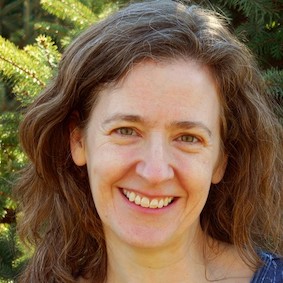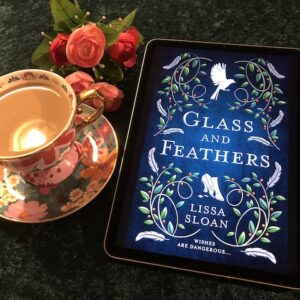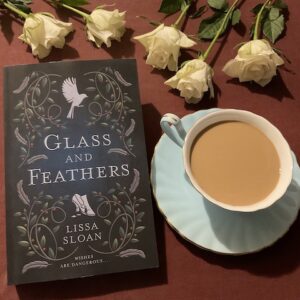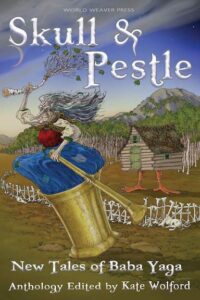 American author Lissa Sloan’s poems and short stories have been published in The Fairy Tale Magazine, Krampusnacht: Twelve Nights of Krampus, Frozen Fairy Tales, and the anthology Skull & Pestle: New Tales of Baba Yaga. I chatted to her about her debut novel Glass and Feathers, a continuation of the Cinderella tale, that takes place after the happily ever after.
American author Lissa Sloan’s poems and short stories have been published in The Fairy Tale Magazine, Krampusnacht: Twelve Nights of Krampus, Frozen Fairy Tales, and the anthology Skull & Pestle: New Tales of Baba Yaga. I chatted to her about her debut novel Glass and Feathers, a continuation of the Cinderella tale, that takes place after the happily ever after.
(You can read my review here.)
 Why did you choose Cinderella as the MC of your book?
Why did you choose Cinderella as the MC of your book?
When it came to Glass and Feathers, I think Cinderella chose me, rather than the other way around, and it all started with the glass slipper. I had a story that had been rattling around inside me for years. It was about someone who does not fit in, and a quintessential element of Cinderella stories is that she does fit – perfectly. In fact, she is so unique that literally no one else can fill her shoes. And sometime in the course of my life, the idea of a slipper made of a material that is beautiful but dangerous and the lengths someone would go to fit it had really gotten under my skin. So when I had the idea of a princess who, after the royal wedding, finds her famous glass slippers no longer fit – she no longer fits – I realised this was the perfect fairy tale to tell this story I needed to write.
What do you love about her story and her character?
Cinderella is a survivor. The more Cinderella tales I read, the more I am struck by her ability to bounce back. At the very least, she weathers neglect and abuse. But in some tales, it’s worse. In some variants, she gets swallowed by a whale or sees her mother killed and eaten by her sisters, or she has to kill her animal helper or give up her children. And through it all, she perseveres. In Glass and Feathers, I wanted to dig in to the consequences of this character’s experiences. What if her happily ever after wasn’t quite as easy and perfect as we assume? What if she had doubts? What if she made some foolish choices?
What do you not love about her?
To me, the beauty of fairy tales is in the huge variety of ways the reader can explore them. But one thing that has long stuck with me about Cinderella is the unspoken message that what makes her (and women in general) worthwhile is her body. The unkind (sometimes ugly) sisters have big feet, so they’re laughable, maybe even villains. Cinderella is a kind, hard-working young woman who survives everything that is thrown at her. But in her story, what seems to matter most is that she is beautiful with tiny feet. She not only fits this petite and delicate shoe, but she also fits the ideal criteria of feminine beauty and sexuality. Therefore, she is worthy of a happy ending no other woman in the kingdom can achieve.
Another thing that really bugs me is the versions in which Cinderella has a deadbeat dad. In Aschenputtel, for instance, her father basically gives her up and does nothing to defend her in favour of his wife and stepdaughters.
 Why do you think Cinderella is the most popular princess, and the story so enduring? (I was editor of Disney Princess magazine in Australia for a few years, and she was the hands down favourite…)
Why do you think Cinderella is the most popular princess, and the story so enduring? (I was editor of Disney Princess magazine in Australia for a few years, and she was the hands down favourite…)
I can’t exactly tell you, because Cinderella was never my favourite princess. The version of the story I was first introduced to (the animated Disney movie) didn’t really interest me. Except for the pretty pink dress made over by the mice. Obviously. The soundtrack of the Rogers and Hammerstein musical starring Julie Andrews resonated with me a little more, as her character is introverted and really lives in her imagination – and as a kid, I absolutely got that (I still do, actually).
But it wasn’t until Into the Woods came along that I saw a Cinderella that really appealed. I loved that she was so unsure about her whole situation, fleeing the prince but making a conscious choice to leave one shoe behind, effectively putting the choice in his hands. And while deciding “not to decide” is kind of a passive choice, for someone who has been conditioned to ignore her own wants and needs to such an extent that she doesn’t even know what she wants, it absolutely makes sense. Into the Woods may not have been my introduction to the Grimms’ version of Cinderella, but it certainly cemented it in my mind as preferable to Charles Perrault’s Cendrillon. And recently I have been delving into many more Cinderella tales. Every Tuesday I post a new one with the hashtag #AnotherCinderella on X, Instagram, and Facebook, and I have loved discovering all of these different tales!
What is it about her that speaks to women so different to her?
There are Cinderella stories the world over, and there is a huge variety among those tales. The heroine may face giants, she may have an eel as her helper, or a fish, or have to promise her firstborn to a dog. The protagonist may be not a heroine but a hero. And yet, there are elements in common that enable us to recognize Cinderella in there among the ashes. There is usually a magical helper, an unkind family, an item left behind that only she can fit.
When it comes down to it, I think Cinderella’s greatest appeal is in her underdog status. Nearly everyone has had a situation in their lives (whether in the family sphere or elsewhere) where they feel downtrodden, unloved, and unworthy. So to see the girl in the ashes go from despised and neglected to the ultimate in special – there’s a huge sense of relief, pleasure, and even vindication for the reader who identifies with her.
What of her story did you most enjoy subverting?
I suppose the idea of the heroine’s physical perfection and immediate “fitting in” to her husband’s world. I wouldn’t say I enjoyed it precisely, but digging in to the idea of reducing a woman down to her appearance alone and how that pressure to be something she’s not can be so damaging that she acts very much against her own interests, was extremely satisfying to me. But I did love turning the traditional happy ever after on its head and exploring this character healing from those deep hurts and finding her true place and purpose in the world.
 You also have a story in the anthology Skull & Pestle, alongside Kate Forsyth and others. What do you love about Baba Yaga and Vasilisa, and what inspired your take on their story, which I really enjoyed?
You also have a story in the anthology Skull & Pestle, alongside Kate Forsyth and others. What do you love about Baba Yaga and Vasilisa, and what inspired your take on their story, which I really enjoyed?
There is so much to love about Vasilisa the Fair (aka Vasilisa the Brave or Vasilisa the Wise)! For one thing, of course, it’s a Cinderella tale: a motherless girl, bullied by her stepfamily, magical helper, great marriage at the end (though the marriage seems almost an afterthought). But I love how dark it is. To get the light her stepmother requires, Vasilisa must journey through the woods on her own – at night. While her doll, who is one of her magical helpers, is kind and nurturing, her other helper, Baba Yaga, is pretty terrifying. And the light Baba Yaga gives her (fearsome burning skull on a stick), doesn’t just fulfill the stepmother’s request – it takes care of both stepmother and stepsisters. For good. This story has bite, and I love it for that. And Baba Yaga is the same. She’s wild and ambiguous; you never know if she’s going to aid someone or eat them.
With my story A Tale Soon Told, I wanted to explore the woman’s life stages of maiden, matron, crone, and I wanted to play with the idea that we don’t just have fairy tale journeys when we are young. Our stories don’t just end at happy ever after. (I guess that’s a theme with me.) Vasilisa marries the Tsar – great! But what happened after? I went looking for other Baba Yaga tales I could play with to answer that question as Vasilisa journeys through her life.
Are you writing a new story now? Will it be faery-tale inspired? Can you give a hint of it?
I don’t see myself getting away from fairy tales, probably ever, but certainly not any time soon. At the moment I’m working on a short story that takes place during the action of Glass and Feathers. It’s based on The Goose Girl, and I hope to share it soon!
You can read more interviews with Lissa, as part of her blog tour, here and here.


Get Social